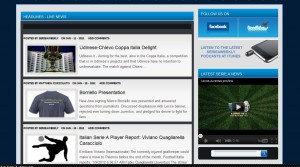Legend of Calcio: Roberto Mancini
Roberto Mancini was born 27th November 1964 in the town of Jesi, of the Province of Ancona, Marche. This small town in central Italy was the place which saw Roberto first fall in love with the beautiful game.
As a boy, his only two interests were football and religion. He was a committed Roman Catholic, and as such honoured his faith by being an altar boy at his local place of worship, the church of San Sebastian.
His football club Aurora Calcio was next door, and a young Roberto Mancini was often found training or playing games there during the early seventies.
His two passions once famously clashed when Roberto left midway through his First Holy Communion to join his teammates for their Sunday fixture. The initial reaction of his family was dismay, until the priest conducting affairs informed them it was he who instructed the young Mancini to get his boots, as his team was 2-0 down.
These were the humble beginnings of a man who would go on to make over 500 appearances in Serie A, inspiring Sampdoria to domestic and European glory, something they hadn’t achieved before, and haven’t since.
Bologna were the first to see Mancini’s talent and signed him at the age of fourteen. He was handed his debut at the age of sixteen in September of 1981. Mancini scored nine goals in thirty-one appearances for the Rossoblù, although his first season proved to be his last.
Sampdoria saw something special in the young forward and brought him to the Stadio Luigi Ferraris in the summer of 1982. Little did they know just what great success he would bring with him.
Mancini’s first season at Sampdoria saw him score only five goals, although he did reach double figures in his sophomore term. It was his third season at the Blucerchiati, the 1984-85 campaign, that Mancini had his first taste of success.
A 3-1 aggregate win over Milan, courtesy of goals from Graeme Souness and Gianluca Vialli, along with a penalty from the man himself, saw Sampdoria win the Coppa Italia for the first time in their history.
The following season saw Sampdoria in another Coppa Italia final, and despite Mancini scoring in the first-leg, they lost out to AS Roma 3-2 on aggregate.
Mancini’s influence was growing, as was his fearsome strike partnership with Gianluca Vialli. Two more Coppa Italia’s followed in 1988 and 1989. Vialli and Mancini were both on the scoresheet as Sampdoria destroyed Napoli 4-1 over two legs to claim their third trophy in five seasons.
The best was yet to come though. The 1989-90 campaign saw Sampodoria win the European Cup Winner’s Cup, this was when the tournament was still held in high regard.
Vialli’s two extra-time goals against Anderlecht on that balmy night in Sweden ensured European glory for Sampdoria and Mancini, all that eluded them now was a league title.
They didn’t have to wait long. The very next season Sampdoria were celebrating their first and only Serie A title win. Mancini’s influence was clearly felt, his sixteen goals in all competitions was his best return in the blue of Sampdoria.
By this point Mancini had reached God-like status in Genoa, and there was simply no stopping his side. Sampdoria swept aside everything before them in the Champions League, reaching the final in 1992.
Captain Mancini walked out to a packed Wembley Stadium in London to face a star-studded Barcelona side. Sampdoria were against a team boasting the likes of Josep Guardiola, Hristo Stoichov, Michael Laudrup and Ronald Koeman. The Blaugrana were managed by Dutch legend Johan Cruyff.
The situation was beyond all Sampdoria’s fans wildest dreams, but as the minutes passed by, the unthinkable looked increasingly possible. A tight game was decided in the 117th minute from a Ronald Koeman free-kick for Barcelona to claim their first European Cup.
Although the pain of an extra-time loss was undoubtedly bitter, Mancini and Sampdoria had done themselves truly proud. Another Coppa Italia success was celebrated in 1994, with a 6-1 mauling of Ancona making it a fourth win in this competition for Mancini.
Despite Mancini’s heroics at club level, he enjoyed only a modest international career. Never a first-team regular, Mancini made thirty-six appearances for the Azzurri, scoring only four goals. With competition from Vialli, Francesco Totti, Alessandro Del Piero and Roberto Baggio though, this doesn’t come as a surprise.
Three more seasons with the Blucerchiati yielded thirty-nine goals, before his fifteen year relationship with Sampdoria ended in 1997. Mancini spent three extremely successful seasons at Lazio before deciding to call time on his playing career (I’m not counting his time at Leicester City).
During his spell with the Biancocelesti, Mancini won two more Coppa Italia’s, bringing his total to six. He was part of the team that won the last ever Cup Winners Cup in 1999, before receiving another Serie A winners medal in 2000.
Despite his cool image as a manager, Mancini does have a crazy side to his personality. Mancini told The Sun how he often was involved in training ground fights, including scraps with Trevor Francis and Liam Brady.
Juan Sebastian Verón also revealed in an interview with The Guardian that the fiery Italian once stripped to the waist to fight him following a minor argument about a poorly taken corner-kick. Perhaps this is why he has so much time for Mario Balotelli?
Roberto Mancini made over 700 career appearances for Bologna, Sampdoria and Lazio, scoring over 200 goals. He won thirteen trophies. This, along with the character he showed on and off the pitch, and his truly inspirational leadership qualities make him a bona fide legend of Italian football.
Mancini scores one of many during his time at Sampdoria.
Ryan Smith


 Send us a timely, compelling post and we'll consider it for publishing on the site with mention of your name and social-media link.
Send us a timely, compelling post and we'll consider it for publishing on the site with mention of your name and social-media link.




